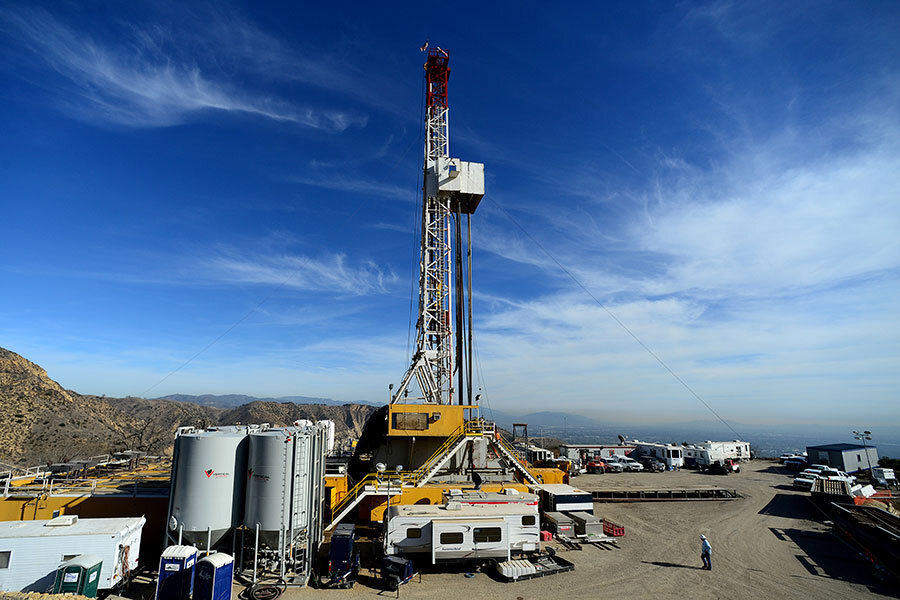One year after Aliso Canyon blowout, feds propose national safety standards
Loading...
| Washington
A year after a blowout at a natural gas well near Los Angeles spewed tons of noxious gas and drove thousands from their homes, a federal task force is recommending dozens of safety changes for the nation's 400 underground natural gas storage facilities.
A report released Tuesday recommends that operators of gas-storage sites conduct strict risk assessments and develop robust safety procedures, including ensuring that storage wells have backup systems to contain gas flows in the event of a leak.
The leak at the Aliso Canyon well was the largest-known release of climate-changing methane in US history, according to scientists. It spewed an estimated 107,000 tons of methane before being controlled in February. The blowout sickened residents in the Porter Ranch neighborhood and surrounding suburbs.
"Natural gas plays an important role in our nation's energy landscape, and we need to make sure the associated infrastructure is strong enough to maintain energy reliability, protect public health and preserve our environment," said Franklin Orr and Marie-Therese Dominguez, who co-chaired the interagency task force.
The failed Aliso Canyon well was one of 115 wells at a sprawling storage facility operated by Southern California Gas Co. The well was built in 1953 to pump oil and converted in the 1970s to store natural gas. It used a design that made it dependent on a single barrier to contain the gas. When that barrier failed, a blowout reported Oct. 23 spewed methane uncontrollably for nearly four months.
The sheer volume of methane released into the California air single–handedly threatened to undermine the state's efforts to cut back on greenhouse gas emissions, as The Christian Science Monitor's Pete Spotts reported in December 2015:
At its peak in late November, the leak from the fifth-largest underground gas storage facility in the US was releasing 58 metric tons of methane an hour, according to preliminary estimates from the California Air Resources Board. By mid-December, the release had eased to 36 metric tons an hour.
...
The effect of the leak on the state's greenhouse-gas emissions is comparable to adding 7 million cars to the road, says Timothy O'Connor, director of the Environmental Defense Fund's oil and gas program in California.
SoCalGas has pleaded no contest to a criminal charge and agreed to pay $4 million in a settlement with prosecutors. The deal requires the utility to adopt a leak-monitoring system at the facility that goes beyond federal and state requirements.
SoCalGas has estimated costs of $717 million related to the leak, including about $500 million to relocate about 8,000 families uprooted as a result of the accident.
A company spokesman said SoCalGas has cooperated with the federal task force and is "committed to supporting forward-looking and reasonable regulations that promote safety at natural gas storage facilities."
Over the past year, the company has worked with local, state, and federal officials to improve safety and enhance technology at Aliso Canyon, spokesman Chris Gilbride said Tuesday.
The task force makes a total of 44 recommendations to industry and government regulators to reduce the likelihood of future gas leaks and minimize impacts of leaks that occur.
"No community should have to go through something like Aliso Canyon again," Mr. Orr and Ms. Dominguez said. "Companies operating natural gas storage facilities should adopt the recommendations as quickly as possible to reduce the risk of future leaks."
Orr is an undersecretary of energy. Dominguez is administrator of the Pipeline and Hazardous Materials Safety Administration
Dominguez said at a news conference Tuesday that her agency expects to announce interim federal rules for natural gas storage operations by the end of the year. The rules would apply to the nation's 400 underground natural gas storage sites, scattered among 30 states.
Currently there are no federal regulations on gas storage. Regulations are left to states and local jurisdictions.
The report released Tuesday focuses on the 12 largest sites, including Aliso Canyon and another California site, as well as five in Mississippi, three in Louisiana and one each in Michigan and New York.
Improved safety standards are especially important, given the country's increased reliance on gas-fired plants to provide electricity, the report said. "While incidents at U.S. underground natural gas storage facilities are rare, the potential significant consequences of those incidents require additional actions to ensure safe operations," the report said.
Mark Brownstein, vice president of the Environmental Defense Fund, an advocacy group that has pushed for stronger safety standards, hailed the report, but said the true test will be in the new federal regulations.
Many of the 400 underground storage facilities nationwide "are old and have problems related to initial well construction and long-term corrosion," Mr. Brownstein said. "The older these systems get, the more leaks and blowouts become a problem. Right now we're effectively crossing our fingers, hoping for the best."
Aliso Canyon is the largest gas storage facility west of the Mississippi River and a major source of energy for the Los Angeles area. Energy officials have warned of possible blackouts if it is not able to resume operations.







